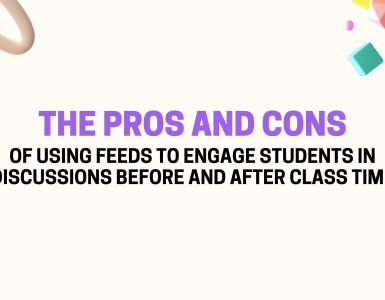Feedback is defined as a return of information. In the classroom, Feedback can be defined as “information allowing a learner to reduce the gap between what is evident currently and what could or should be the case.”
In today’s classroom, feedback has become an essential component of a learner’s learning process. Collecting feedback can provide educators and students clear guidance on performance, self-awareness, and can increase class morale while learning.
There are great benefits in implementing feedback-driven activities into your course structure. Collecting feedback during the semester will lead to a healthy learning environment, increase learners’ comfort level, and improve their confidence.
Feedback is one of the most influential factors in learning, as powerful as the quality and quantity of instruction. In this blog, we cover why you should ask for feedback in class, and we give you a few ideas to try while using CampusKnot.
Why ask for feedback?
- Build better relationships between students and instructors.
- Help promote an environment of communication.
- Motivate students to participate in class and take an active role in their learning.
- Encourage growth and course rapport.

Luckily, inside a classroom, there are multiple ways to gain immediate feedback on student performance. Gaining real-time feedback allows instructors to build engaging and fun classes and can also lead to higher participation.
The modern student belongs to a generation that relies heavily on making social connections inside and outside social spaces. Recent studies have found that Gen Z students go to great lengths to improve their education. Asking for immediate feedback rather than waiting for teacher evaluations can help you better assess and adapt course content to fit the needs of Gen Z students.
Here are few ways to increase class participation while implementing feedback-driven activities inside a class:
Survey your students
Engaging your students via polls allows the closest learners and the most participative students to be equally heard. Through polling, you are inviting students to interact with class material while participating with you. Polls allow you to run a couple of activities in class, such as:
- End of the week assessment can help you gauge how students are handling class material.
- Anonymous polls can turn project-based learning reviews into an easy task for you. Students can rank and give feedback on their experiences while working with classmates or group members.
- Trivia Game where you can poll students on class content you covered in your lecture. This game allows students who gained the most points to receive extra credit for participating.

Inside CampusKnot, you can take feedback even further by rewarding those who are actively participating in class. CampusKnot’s foolproof attendance makes it easy for students who are present in class to gain points based on their attendance.
Make it interactive
According to a recent study, Gen Zers are more active online than any other generation. About 95% own a smartphone, 83% own a laptop. Communication is at their fingertips at all times, which is why starting class with questions through a medium that is relatable to them is a great way to encourage interaction.
Here are a few ideas to encourage students to participate while gaining feedback on class content:
- Trivia prep-opportunity, this activity will decrease the time you spend coming up with quiz or test questions. Ask students to come up with 1-2 questions. Students automatically earn points for participating. You can take this activity further and give extra credit to the student post with the most number of votes or 👏🏽 s.
- Flipped-learning activities can determine whether or not students have fully understood previous class material. Start by creating a discussion post inside the CampusKnot feed where students can post questions related to previously viewed class material. This activity can ignite meaningful conversations at the beginning of class while only taking 3-5 minutes of class time.
The CampusKnot feed is a great way to get Gen Z learners talking. We have implemented positive aspects of social sites to create relatable and low-anxiety learning communities. Whether you use polls, questions, or discussion-driven activities, keep a few of these questions in mind:
- Where is the class going? (goals)
- How are we doing? (progress)
- Where to next? (to more complex and interesting challenges, not just “more.”)
Making class fun and inviting doesn’t have to be time-consuming. Feedback can increase student performance and level of comfort. The power of feedback inside a class can improve student retention and drive meaningful interactions. Start gaining feedback in class with CampusKnot; it’s free!




